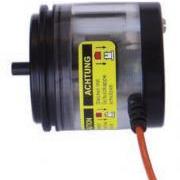Nonmetallic Rotary Encoder Is Well Positioned for MRI Applications
September 23, 2010
|
A nonmetallic rotary position sensor can operate with complete "transparency" in extreme electromagnetic fields. |
The electromagnetic environment of MRI machines is hostile for electronic sensors and components. Consequently, these components must be made of nonconductive, nonmetallic materials. In addition, monitoring body responses during MRI procedures is problematic because the magnetic fields impair measurement capabilities. Addressing these challenges, Micronor Inc. has developed what it says is the first and only commercially available nonmetallic rotary position sensor that can operate with complete "transparency" in extreme electromagnetic fields.
"The MR318 fiber-optic rotary encoder is the first product that can measure mechanical movement under very high magnetic fields without being influenced by them and without influencing the magnetic fields it operates in," explains Robert Rickenbach, Micronor's president and chief engineer. Among its benefits, the encoder allows medical personnel to monitor the brain activity of patients while they are engaged in various locomotor activities, enabling researchers and radiologists to develop MRI-compatible test and diagnostic equipment.
Underlying this performance capability is the device's phase-sensitive light-barrier concept. Two spatially separated beams of light with wavelengths of 850 and 1300 nm pass through slits in a rotating disk. The disk alternately blocks or transmits the light as it rotates around its axis. The two beams are then recombined and coupled back into the optical fiber. At the controller end, the modulated light beams are separated and converted into electrical signals, providing the information required by the A and B quadrature signals typical of incremental encoders. A microprocessor constantly monitors and adjusts the optical signals to compensate for light-intensity variations in the optical fiber.
"To build an MRI-enabled device, one has to carefully eliminate any ferrous and conductive materials," Rickenbach says. "And when considering materials for high magnetic electrical fields, it is obvious that nonferrous materials are also out." Because MRI machines employ nonsteady magnetic fields, electrically conductive materials are susceptible to induction and the resulting eddy currents that disturb the MRI-generated magnetic field. They can also cause heat buildup in the material. Thus, the MR318 incorporates high-grade fully ceramic ball bearings with a special lubricant that is inert to magnetic fields. In addition, the sensing disk is made from a highly resistant, nonconductive photographic-type film on a Mylar-type substrate.
"Prior to the MR318, no commercial sensor was available for measuring continuous position within MRI chambers," Rickenbach says. "This encoder enables a fully functional motion control apparatus with closed-loop feedback."
Micronor Inc.
Newbury Park, CA
www.micronor.com
You May Also Like



